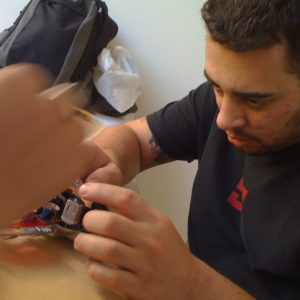-

Toy Hack for opening the cultural black box
Last saturday, I organized a Toy Hack workshop at the brazilian national design students meetup with the purpose of invinting young designers to open the black box of electronic products, mix it’s components and see what happens. The new frankentoys created by the participants are shown in this video (portuguese): Industrial Designers are commonly not […] - Jul 20, 2010 -

The Church of the Divine Design (2010)
The Church of the Divine Design is a provocative design fiction project developed at Faber-Ludens Institute for Interaction Design. This initiative humorously critiques and explores the role of design and designers in contemporary society by parodying the rise of Protestant work ethic and corporativism in Brazilian design practice. It seeks to engage the public in […] - Jul 11, 2010 -

Communal virtualities and complicated pleasures
At the beginning of the Internet, we spoke a lot about virtual communities. We believed that we could create new worlds without borders and conflicts, driven by the information flow and organized by explicit interaction rules. The more the network becomes popular, the more the cyber-utopia gets sallow. What people wants is not information but […] - Jul 9, 2010 -

Trends, cliches and cultural reproduction in Design
Design is sometimes used as synonymous with innovation, creativity, innovation, cutting edge. But how much design is able to bring the new? The society fears and rejects movements that propose radical changes, such as the Landless Movement, hackerism and Punk, but deify changes proposed by design because this changes do not threaten the status quo, […] - Jul 9, 2010 -

Critical games to reflect on violence
Often, videogames are considered the cause of inadequate violent acts. Traditional media prefer to find an easy culprit instead of discussing the broader problem: the origins of urban violence. The gamer that enacts an inadequate violent act would do it by the influence of videogames. To avoid this behavior, the gamer should not be exposed […] - Jul 7, 2010 -
In my Interaction Design Foundations course, I explain to students that tangible interfaces are becoming widespread because they explore the human body as an input device. This makes the interaction more sociable and affective. In one class, I brought a Dance Dance Revolution pad for our students to experiment with and they took it to […] - Jul 7, 2010
-

Customer necessity is the mother of invention
The first thing to do when starting a project is defining its goals. Sometimes, the goal can be broken down in sub-goals, but one of them must prevail and, generally, this goal accounts for company needs, not customer needs. For example, the overused goal “increase customer loyalty” emerges from the company need of retaining current […] - Jul 7, 2010 -
From Interfaces to Interactions: Participatory Design of the BrOffice.org Portal
Abstract The complexity of communication processes mediated by technology has attracted the attention of several areas. In a pragmatic perspective, Interaction Design strives for designing these medias for a particular community, however this process occurs within a political scenario of cultural conflicts. The option of participatory design advocates the individual´s autonomy to develop social uses […] - Jul 7, 2010 -
After blogging for 6 years in portuguese on Usabilidoido, now I start to talk with the international community. - Jul 7, 2010
-
Power over Mediated Agency and its Ethical Implications for Interaction Design
AbstractThere is little discussion about power within Interaction Design field. To call attention to this issue, we present a model for discussing conflicts that arises at the human-artifact interface. We argue that artifacts support human behavior by providing adaptations, but these adaptations can expand or restrict human actions. Human action cannot be fully controlled by […] - Jul 7, 2010
Frederick van Amstel
Design researcher & educator